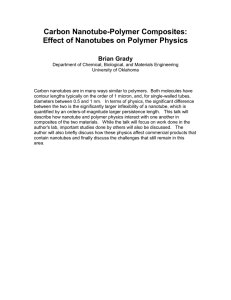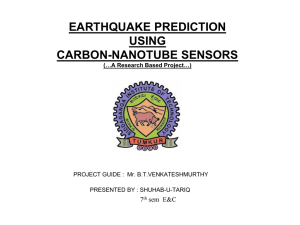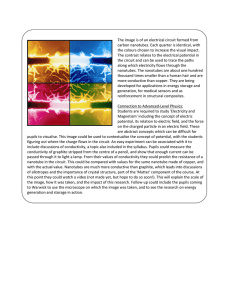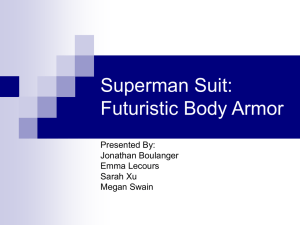Alpha_1 Nanotechnology Modeling Feasibility Demonstration
advertisement
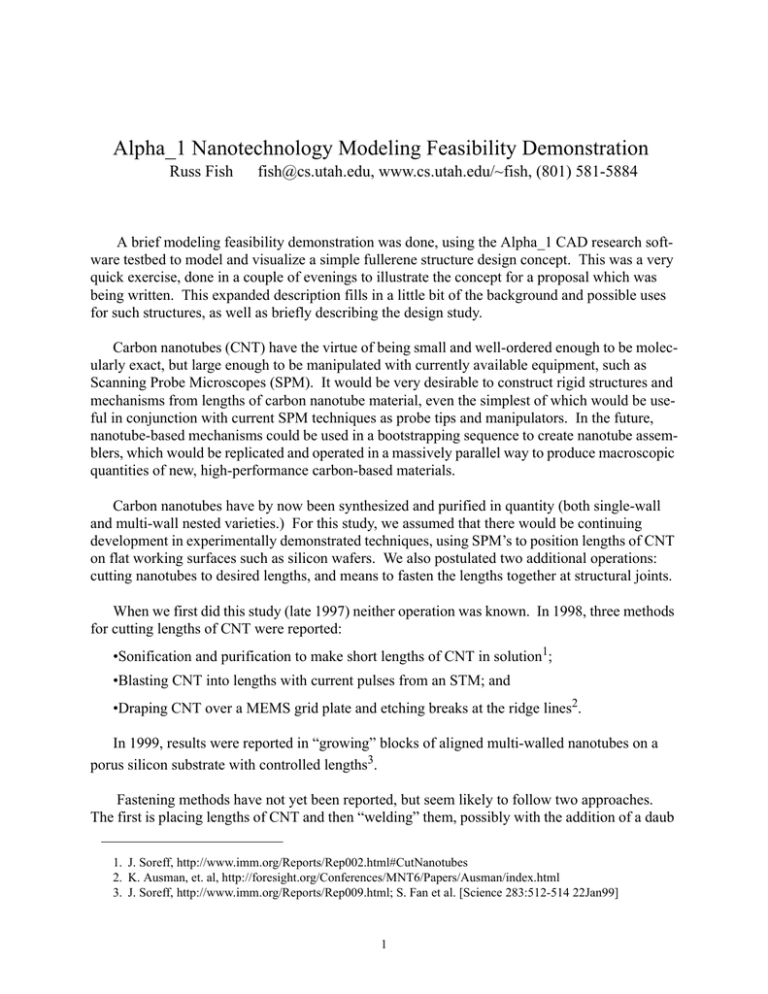
Alpha_1 Nanotechnology Modeling Feasibility Demonstration Russ Fish fish@cs.utah.edu, www.cs.utah.edu/~fish, (801) 581-5884 A brief modeling feasibility demonstration was done, using the Alpha_1 CAD research software testbed to model and visualize a simple fullerene structure design concept. This was a very quick exercise, done in a couple of evenings to illustrate the concept for a proposal which was being written. This expanded description fills in a little bit of the background and possible uses for such structures, as well as briefly describing the design study. Carbon nanotubes (CNT) have the virtue of being small and well-ordered enough to be molecularly exact, but large enough to be manipulated with currently available equipment, such as Scanning Probe Microscopes (SPM). It would be very desirable to construct rigid structures and mechanisms from lengths of carbon nanotube material, even the simplest of which would be useful in conjunction with current SPM techniques as probe tips and manipulators. In the future, nanotube-based mechanisms could be used in a bootstrapping sequence to create nanotube assemblers, which would be replicated and operated in a massively parallel way to produce macroscopic quantities of new, high-performance carbon-based materials. Carbon nanotubes have by now been synthesized and purified in quantity (both single-wall and multi-wall nested varieties.) For this study, we assumed that there would be continuing development in experimentally demonstrated techniques, using SPM’s to position lengths of CNT on flat working surfaces such as silicon wafers. We also postulated two additional operations: cutting nanotubes to desired lengths, and means to fasten the lengths together at structural joints. When we first did this study (late 1997) neither operation was known. In 1998, three methods for cutting lengths of CNT were reported: •Sonification and purification to make short lengths of CNT in solution1; •Blasting CNT into lengths with current pulses from an STM; and •Draping CNT over a MEMS grid plate and etching breaks at the ridge lines2. In 1999, results were reported in “growing” blocks of aligned multi-walled nanotubes on a porus silicon substrate with controlled lengths3. Fastening methods have not yet been reported, but seem likely to follow two approaches. The first is placing lengths of CNT and then “welding” them, possibly with the addition of a daub 1. J. Soreff, http://www.imm.org/Reports/Rep002.html#CutNanotubes 2. K. Ausman, et. al, http://foresight.org/Conferences/MNT6/Papers/Ausman/index.html 3. J. Soreff, http://www.imm.org/Reports/Rep009.html; S. Fan et al. [Science 283:512-514 22Jan99] 1 of fastening or catalyst compound (“glue” or “flux”). The alternative is the more elegant chemical approach of functionalizing the pentagonal sites at the ends of CNT lengths in quantity while they are still in solution, so that the CNT members would “want” to align and bond strongly to each other (possibly after exposure to a solvent or catalyst to avoid the difficulties of placing “sticky” members.) The properties of built-up CNT trusses will depend on the truss geometry, the diameter and type of nanotube members used (single-wall or multi-wall), and perhaps most crucially on the fastening techniques. Back to the modeling feasibility study: I created an Alpha_1 model of an exact unit icosahedron1 as a starting point (rendered in Figure 1), to establish the fullerene symmetry. I verified that the double-precision floating-point coordinates used in Alpha_1 give 16 digits of accuracy on the edge lengths of the symmetry icosahedron, since there’s no point in modeling macro-scale structures down to the atomic level if you don’t have sufficient range of precision. In fact, 16 digits is sufficient to represent atom locations within a ten kilometer sized design space with a resolution of a thousandth of a nanometer, plenty of precision for a nanotech design system foundation. Figure 1 - A precise icosohedron. 1. Formula 10.41 from Coxeter’s Introduction to Geometry, p. 156. 2 An Alpha_1 model of a C-60 buckminsterfullerene “buckyball” molecule was created next, as shown in Figure 2. Published experimentally measured double and single bond lengths were used in the icosahedron symmetry framework, combining mathematical relationships with experimentally measured data. (Because of the difference between single and double carbon bond lengths, the buckyball resembles a soccer ball, but doesn’t have the exactly equal edge lengths of the mathematical truncated icosa-dodecahedron.) The buckyball is rendered in both skeleton and ball-and-stick forms in Figure 2, demonstrating the useful ability to substitute either detailed or abstract simplified member geometry into the patterns of the parametric Alpha_1 models. This helps to avoid swamping the available level of computing and graphics capabilities. Figure 2 - A C-60 buckminsterfullerene “buckyball” molecule. 3 Figure 3 shows a family of capped single-wall nanotubes (CSWNT’s), starting with C-70 through C-90 and going on to arbitrarily long nanotubes (e.g. C-260 and C-1060.) This is the simplest untwisted (non-chiral) nanotube modeling approach, simply splitting the buckyball along the equator and adding C-10 rings, so the number of rings is just a parameter to the nanotube construction function. This should be sufficient for structural studies, but would not reproduce electrical properties of chiral tubes, for instance. Figure 3 - A family of capped single-wall nanotubes. Since we’re interested in stiff structures with members which are relatively short segments of nanotube for this study, the central axes of the modeled nanotubes are straight. There would be no difficulty in using Alpha_1 to lay out atomic models of nanotubes along NURBS curves which represent the axes of deformed members or long curved nanotubes. 4 Next, a model of a simple truss made of CSWNT’s was created, using the a section of the octtet truss symmetry pattern observed in the horizontal boom of a large building construction crane. The arbitrarily-chosen cell size is 3 nanometers. This design is meant to be evocative of a small section of a nanoscale mechanism such as a miniature SPM cantilever, working on a tiny “building site”. Figure 4 - Truss symmetry with abstract beam elements. Figures 4 and 5 sketch the fabrication notion of laying the members out on a planar working surface, attaching them together, and then folding the faces into a three-dimensional beam and fastening the seam. Recently, experiments were reported “where nanotubes were rolled by AFM tips on graphite surfaces.”1 Furthermore, “This technique allows controlled rotation of nanometer-scale objects around an axis in the plane of the substrate. This permits lifting planar workpieces out of the plane of the substrate for the construction of 3D objects.“ 1. J. Soreff, http://www.imm.org/Reports/Rep009.html; M. R. Falvo et al., [Nature 397: 236-238 21Jan99] 5 In the parametric modeling of the truss, a procedure wraps the simple logic to connect any two points in space with a nanotube, abstracting away all of the lower-level details and computing the number of C-10 rings in the molecular model from the distance between the end points. Furthermore, a switch parameter to the model shows either single line-segments representing the beam elements, in Figure 4, or detailed nanotube molecular models in Figure 5. (Joint attachment details are as yet unknown.) Figure 5- Nanotruss with nanotube beam elements. 6 Eric Drexler described future automated engineering systems that will generate assembler command programs1. Storage management of designs would be a big problem if the complete hierarchy of details were generated beforehand and transmitted for execution. We would address this by procedurally generating design details as needed in local neighborhoods, in a top-down hierarchy from the overall product design level down to individual assembler instruction sequences. (Our commercial FeatureCAM software from EGS does this now at a single level from feature-based design models of mechanical parts, generating fabrication programs for computer numerically controlled machining equipment.)2 To build up a macroscale truss design, one could substitute built-up nanotruss elements for the elementary nanotube elements in similar truss structures at higher and higher scale levels. This practice is sometimes seen on highway and railway bridge trusses, where the beam elements in the bridge truss are themselves built-up trusses riveted together from angle and flat bar stock. Adopting a 10x scaling factor between levels, it would take only 8 levels to go from the arbitrarily-chosen 12 nanometer length of the nanotruss segment shown here to a 1.2 meter long macroscale structure segment. Figure 5 can be seen in this light as representing the first of a series of ever higher order-of-magnitude views of built-up trusses, with each level constructed of elements which are trusses from the next smaller level of detail. From the top-down point of view, the result would be a recursively structured self-similar (fractal) porous material. Of course, massively parallel nanoscale fabrication equipment would be required to economically “knit” objects out of such a material. Drexler describes convergent assembly arrangements in “Nanosystems” which would make this a continuous fabrication process. This could be done by speciaized “dumb” mechanisms actuated by fixed linkages and very efficiently producing quantities of a single material. It is also interesting to consider whether programmable fabrication equipment could be built out of this same material, creating a technology that qualifies as an “assembler”, a self-replicating manufacturing system capable of making a wide variety of products, including more assemblers. The feedstock of the manufacturing system would be largely composed of carbon nanotubes produced chemically and packaged for easy handling, e.g. the previously-cited blocks. To the extent that methods can be developed to grow or trim the carbon nanotubes to consistent lengths in parallel, these blocks would be an attractive feedstock from the bottom level of our notional truss assembler. Employing the building-site analogy once more, this would be like delivering neatly-stacked pallets of structural members to be individually fastened into the emerging structural framework. Proceeding to further work in this direction, we could study further variants of the recursive truss design motif of Figure 4, but use only one member length at each scale level. Leaving the diagonals out of the half-octahedron square pyramids, we could instead bond two trusses together or self-assemble along a midplane to produce a rigid oct-tet truss structure. Given the measured properties of CSWNT’s and assumptions about joint fastening properties, we should be able to calculate the material properties of these recursive trusses, proceeding bottom-up through each detailing scale level to the overall structural properties. 1. “Engines of Design” in Chapter 5 of Engines of Creation, http://www.foresight.org/EOC/ EOC_Chapter_5.html#section03of06 2. Engineering Geometry Systems, http://www.featurecam.com/ 7 For now, we have just used the Alpha_1 CAD software to sketch a possible design space of purely structural elements: carbon nanotube trusses. We envision application of Alpha_1 to nanotechnology to be feasible in at least the following four areas: •Product design and engineering of end-user products; •Mechanical design of the fabrication equipment; •Development of automated detailing methods and “design compilers” to algorithmically translate designs into fabrication instruction sequences on-the-fly at various scale levels; and •Bootstrapping the technology, starting with repeatably operating programmable SPM-based and/or chemical process sequencing experimental equipment when it becomes necessary to transcend manual one-at-a-time control of scienteific and manufacturing experiments. 8
